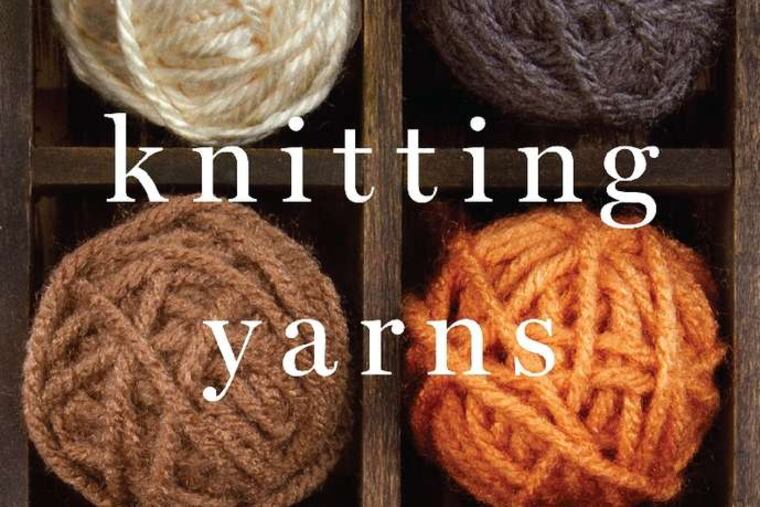27 writers who knit, or watch those who do
The idea of knitting may conjure one of a few static ideas for you: itchy woolen scarves, old-fashioned values, or maybe the up-to-date craft revivalists, with tattoos under their itchy woolen scarves.

Knitting Yarns
Writers on Knitting
Edited by Ann Hood
W.W. Norton. 320 pp. $24.95
nolead ends nolead begins
Reviewed by Katie Haegele
The idea of knitting may conjure one of a few static ideas for you: itchy woolen scarves, old-fashioned values, or maybe the up-to-date craft revivalists, with tattoos under their itchy woolen scarves.
If that's the case, just read this ingenious anthology - a collection of 27 essays, plus a handful of patterns by designer Helen Bingham - and you'll see there's a lot more to it than that. (And while I can't review the patterns because I haven't tried one yet, I can report with pleasure that Bingham lists two yarn options for each design, a rare treat in a world of discontinued boutique yarns.)
In the poetic words of Barbara Kingsolver, knitting is natural and basic and human. "The two-plied strands of your chromosomes have been spun by all thin-skinned creatures for all of time, and now they offer you no more bottomless thrill than the point-nosed plow of prepared-ness." This is certainly a literary bunch; many have at least one bestselling book or O. Henry Prize, and more than one of them name-checks Madame Defarge. (Really.) But regarding handicrafts, they come in a range. There are veterans and beginners, folks who have been knitting since childhood, and those who consider it more of a spectator sport, deriving comfort from sitting beside a friend or a grandmother as the needles click comfortingly.
Though memories of that sensual first visit to the yarn shop are lovely, the collection's strongest pieces interpret the theme in a less obvious way, using knitting as a jumping-off point to tell another kind of story. In "Knitting in Kathmandu," journalist Jessi Hempel recalls her backpacking trip through Asia after college, where she had only ever dated women, and the day she fell in love on a bus in Nepal with a young man who she spied knitting socks on a circular needle. Marianne Leone, whom you may remember as Christopher Moltisanti's mom in The Sopranos, contributes a brief meditation on family, love, and the sense of dislocation created by immigration. Written in a quirky, distinctive voice, it's one of the brightest and funniest pieces in the book.
The wonderful Elinor Lipman has the other funniest one, an epic poem about crafting ambiguity:
And oh the projects I have started,
But then I find myself fainthearted,
I loved this cotton at the store,
But I don't like it anymore.
There is, in fact, a thread (a strand?) of wry humor that runs through this entire collection. Elissa Schappell, who learned to knit as a way to relax and ease her high blood pressure, writes in one laugh-out-loud line: "Soon after - in the way that shoplifters start noticing other people sticking turkeys under their sweatshirts - I started seeing knitters everywhere." Do most good writers have a solid sense of humor? Or is it their shared interest in knitting that gives these ladies their jeu d'esprit? Could it be that writers who knit are the cleverest people in the world? You can guess what this reviewer-knitter thinks.
Like any good anthology, Knitting Yarns introduces us to writers who are new to us, people whose books we will happily add to our ever-growing to-read list. Kaylie Jones was one of those for me; her "Judite" is a heart-breaker of a story about the nanny who raised and loved her (and crocheted metric tons of doilies, blankets, and clothes for the family - even the author's first little bra) while her parents ignored her and threw parties in the flat downstairs. There isn't one real clunker in the whole book, though Sue Grafton's piece is so odd and disjointed you wonder if she chopped it up with scissors like a Dadaist and asked the editor to reassemble it.
One reason for knitting's deep appeal, as most of the contributors mention in one way or another, is the easy sisterhood of it, the way it connects us to generations of women who went before us. Since traditional women's work is her subject, editor Ann Hood was able to assemble a mostly female cast without ever having to identify her book as "women's writing," or some equally awkward designation. And there's something deliciously subversive about that.
But there are a few men in the book, actually, and while in this venue they may be more like honorary women, their view of knitting adds a valuable new dimension to the topic. John Dufresne contributes a gorgeous piece about family traditions and the importance of having roots. Taylor M. Polites, a gay man, attends a colorful and diverse knitting circle in order to get over some of his hangups about "masculinity." By the essay's end, he has taken his hobby to new levels by knitting sweaters for his tiny dog, Clovis. He writes, "Not only had I assumed some gender-subversive behavior, it was age-subversive as well. I was acting like an 80-year-old woman."
Man, woman, whatever: Polites also includes his own knitting pattern, "Clovis' Perfect-Fit Sweater." It's just one delightful surprise in a book full of them.